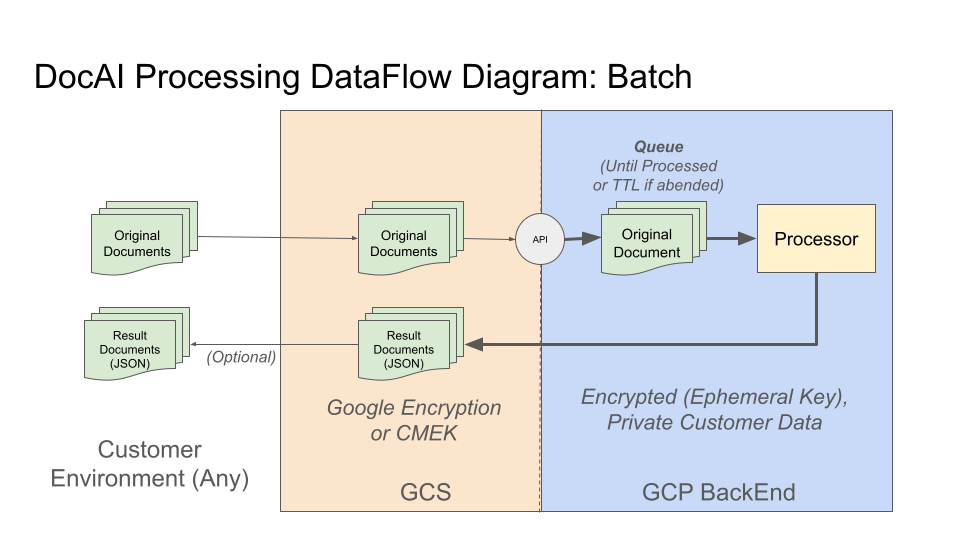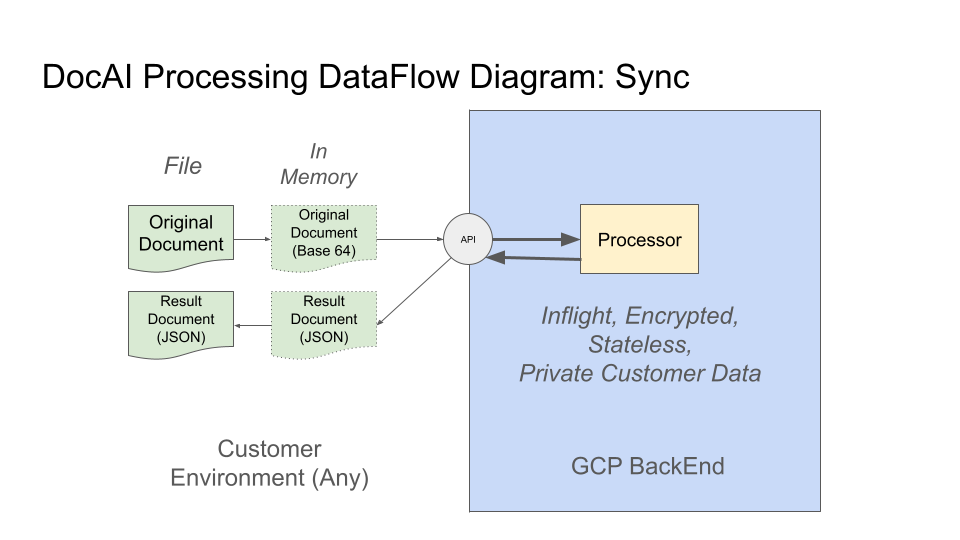以下是适用于各个领域的问题和解答。
安全
如需确保 Document AI 中的服务安全,请查看以下主题。
Google 如何保护我发送到 Document AI 的数据并确保其安全性?
请参阅Google Cloud 安全性页面,了解我们针对 Google Cloud 服务实施的安全措施。
Document AI 提供哪些安全功能来防范在系统之间横向移动的攻击?
Document AI 支持以下内容:
安全合规性
本部分介绍了与合规性相关的问题。
Document AI 提供哪些合规性支持?
Google Cloud 会定期接受独立的第三方审计,以验证是否符合安全、隐私保护和合规性控制方面的要求。 Google Cloud 会定期审核是否符合 ISO 27001、ISO 27017、ISO 27018、SOC 2、SOC 3 和 PCI DSS 等标准。
如需详细了解 Google Cloud 合规性,请访问合规性资源中心。
Document AI 是否符合 FedRAMP 要求?
Document AI 符合 FedRAMP 高风险级别要求。
Document AI 是否符合 HIPAA 的规定?
Document AI 符合《健康保险流通与责任法案》(HIPAA) 的规定。
安全数据使用情况
本部分介绍了数据查询。
Google 是否会使用客户数据来改进模型?
不会。除非是为了向您提供 Document AI 服务,否则 Google 不会将您的任何内容(例如文档和预测结果)用于任何目的。请参阅Google Cloud 《服务条款》的第 17 条。
在 Google Cloud,我们绝不会使用客户数据来训练 Document AI 模型。
如需了解详情,请参阅透明度和数据保护页面。
未来,Google 是否会分享我发送到 Document AI 的文档?
我们不会公开您发送的文档,也不会将其分享给任何其他人,除非是为了提供 Document AI 服务而需要这样做。例如,有时我们可能需要使用第三方供应商来帮助我们提供服务的某些方面,例如存储或传输数据。我们的供应商须承担相应的安全和保密合同义务。我们不会出于任何其他目的将您发送的文档分享给其他方或公开。
Google 会将我发送给 Document AI 的文档、相应结果或与请求相关的其他信息存储在其服务器上多长时间,以及存储在何处?我可以访问吗?

当您使用批量请求将文档发送到 Document AI 时,我们必须在短期内存储该文档(使用临时密钥加密,这意味着没有人可以访问该文档),以便执行分析并将结果返回给您。对于批量操作,存储的文档通常会在处理完成后立即删除,且具有一天的故障安全存留时间 (TTL)。如果批处理异常终止,数据可能会保留最多一天(TTL)。
同步流程

对于在线(立即响应)操作,文档数据(在请求中发送)会在内存中处理,在传输过程中加密,不会永久存储到磁盘。Google 还会暂时记录一些关于您的 Document AI API 请求的元数据(例如收到请求的时间和请求的大小),以改善我们的服务和打击滥用行为。
Google 是否针对我在请求中发送到 Document AI 的内容主张所有权
Google 不会对您传送到 Document AI 的任何内容(包括文档和预测结果)主张所有权。文档和自定义模型被视为(私密)客户数据。我们绝不会使用客户数据来改进模型。在极少数情况下,如果双方都同意此类安排,则会制定明确的数据共享协议。
哪些信息会被视为个人身份信息 (PII),需要在与 Google 共享文档之前进行遮盖处理?
就文档共享而言,PII 是指根据适用法律定义为个人身份数据的任何信息。客户必须在与 Google 分享文档之前对文档进行遮盖处理,例如,为了重现问题而自愿进行遮盖处理以获取技术支持。
PII 的示例包括但不限于:
- 出生日期,例如:
2/10/1988 - 个人姓名,例如:
Kiran Darko - 个人地址,例如:
Evergreen terrace 123 - 个人的电子邮件地址,例如:
rivelro@test-mail.com - 个人的电话号码,例如:
636-555-3226 - 驾照号码
- 国民身份证号码
- 雇主识别号
- 银行账号信息:账号 ID、汇款路线号码、SWIFT ID
- 支付卡号
- 性别,例如:
Female, Male, Nonbinary - 种族,例如:
Berber, Italian, Japanese, Latino, Ukrainian - 用户名、第三方 ID 编号
- 护照号码,例如:
AA1001111 - 婚姻状况,例如:
Single, Divorced - 津贴或免税项的数量
- 相关名称
- 车辆标识符(车辆识别码、车牌号等)
- 可随时间推移或跨服务识别个人消费者、家庭或设备的任何其他唯一标识号、特征或代码
我可以转售 Document AI API 吗?
不可以,您不得转售 Document AI 服务。但是,您仍然可以将 Document AI 集成到具有独立价值的应用中。
客户如何控制 Google Cloud 支持人员对其文档或数据的访问权限?
所有 Document AI 解析器都支持 Access Transparency 和访问权限审批。默认情况下,Google 支持人员无法访问任何客户数据或应用。如果 Google 支持团队需要访问客户数据,客户可以使用访问权限审批流程来授权访问数据或应用。此流程从在 Google 支持门户中创建支持服务工单开始。然后,客户会收到一封通知(通常是电子邮件),其中包含授权或拒绝访问的选项。
Google 还提供一项名为 Access Transparency 的服务,让客户能够了解 Google 支持人员在有权访问系统时执行的所有任务。

